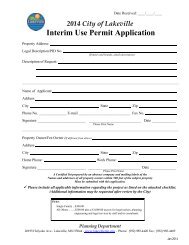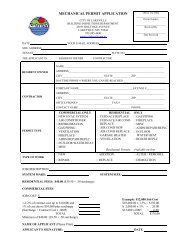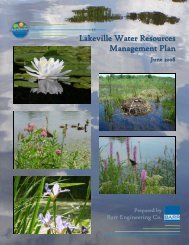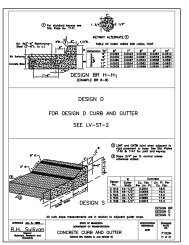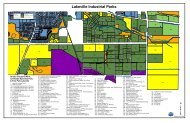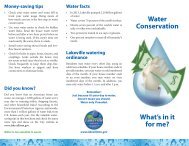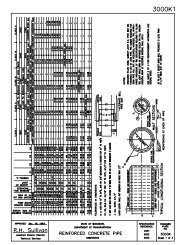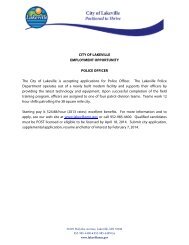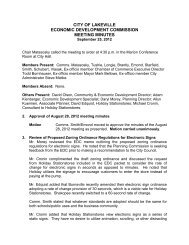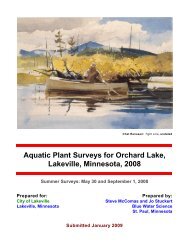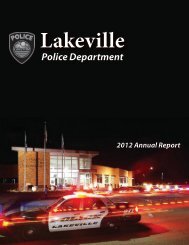2006 Parks, Trails and Open Space Plan - City of Lakeville
2006 Parks, Trails and Open Space Plan - City of Lakeville
2006 Parks, Trails and Open Space Plan - City of Lakeville
You also want an ePaper? Increase the reach of your titles
YUMPU automatically turns print PDFs into web optimized ePapers that Google loves.
Policies - Greenways/Linear <strong>Parks</strong>/Conservancy Areas:<br />
1. Preferably greenways shall include natural or designated corridors such as utility<br />
rights-<strong>of</strong>-way, or natural features such as bluff lines, vegetative patterns, water<br />
features, required natural environment buffers or other characteristics consistent<br />
with the specific recreation or conservation objective <strong>of</strong> the greenway.<br />
2. Conservancy areas shall include natural features such as wetl<strong>and</strong>s, water<br />
bodies, st<strong>and</strong>s <strong>of</strong> significant trees or other vegetation, bluff lines, scenic<br />
overlooks or other natural elements desirable for preservation from an aesthetic<br />
or functional basis.<br />
3. Distinctive natural features that give a greenway corridor or conservancy area its<br />
distinguishing character will be retained wherever possible using every<br />
reasonable effort.<br />
4. Greenway <strong>and</strong> conservancy areas shall be <strong>of</strong> a size <strong>and</strong> configuration to protect<br />
the natural amenities within the designated area, provide wildlife corridors <strong>and</strong><br />
provide trail linkages to the <strong>City</strong>’s parks, trails, designated greenways, natural<br />
areas, <strong>and</strong> other local destinations.<br />
5. To reduce the possibility <strong>of</strong> destroying natural or cultural resources as a result <strong>of</strong><br />
development, the <strong>City</strong>, as part <strong>of</strong> the Comprehensive <strong>Plan</strong>, will create a more<br />
detailed inventory <strong>of</strong> the community’s unique habitats <strong>and</strong> functioning<br />
ecosystems through its GIS data base. This inventory will be used to:<br />
a. Identify special natural areas for permanent protection, either by private or<br />
public action.<br />
b. Identify opportunities for restoration <strong>of</strong> degraded streams or wetl<strong>and</strong>s.<br />
c. Determine opportunities for protecting water infiltration areas or using<br />
alternative storm water management practices.<br />
d. Determine size, configuration <strong>and</strong> location <strong>of</strong> greenways.<br />
e. Identify potential park locations adjacent to future greenways that may<br />
contribute to the <strong>City</strong>’s overall park/trail system.<br />
6. Restore greenways or conservancy areas where necessary to improve their<br />
ecological health.<br />
7. Ensure that greenways <strong>and</strong> conservancy areas serve all community residents<br />
through the protection <strong>of</strong> view sheds <strong>and</strong> the provision <strong>of</strong> pedestrian trails within<br />
the greenway corridor in a manner that will not degrade the natural features <strong>of</strong><br />
the area.<br />
<strong>City</strong> <strong>of</strong> <strong>Lakeville</strong>, Minnesota<br />
Chapter Five<br />
<strong>2006</strong> Comprehensive <strong>Parks</strong>, <strong>Trails</strong>, & <strong>Open</strong> <strong>Space</strong> <strong>Plan</strong> Page 91



